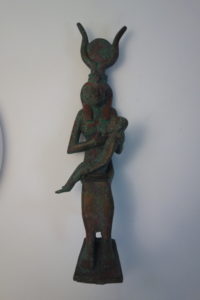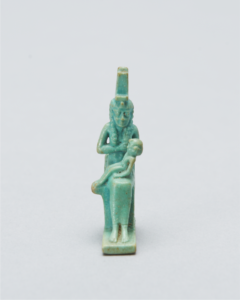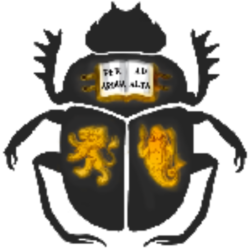The Organic Nature of Isis Imagery
An In-Depth Look at an Isis Statuette
Harry Fowler
In the Eton Myers Collection of Egyptian Art, there is a large[1] bronze statuette (ECM 6008) of Isis suckling the child Horus, known in Greek as Harpocrates. Isis is depicted with a detailed tripartite wig and diadem supporting the horned sun disc crown. This horned crown was also popularly worn by the goddess Hathor.[2] Harpocrates is naked bearing the sidelock, which is a typical identification for Egyptian children, both mortal and divine, in ancient Egypt.[3] Statuettes depicting Isis suckling Harpocrates (a motif known as Isis lactans), similar to ECM 6008, were popularised in the Late Period of ancient Egypt (664-332 BC) and were often made from bronze or glazed compositions. The popularity of the Isis lactans sculptures has been attributed to the democratisation of Egyptian funerary beliefs around the period. The object would have been intended to be a votive offering housed in sanctuaries and other sites of similar stature.
 © Eton Myers Collection, University of Birmingham |
Isis is portrayed as the personification of motherhood, protection, and having great power, all demonstrated through the origin story of Osiris.[4] The protection Isis afforded to her son Horus during his infancy, transferred to the protection of the king following the passing of titles from Horus to the first king Menes.[5] Here one can see the association with the name based on the origin story, Isis being the Greek for Is.t meaning ‘throne’ in Egyptian.[6] The imagery of Isis with Harpocrates became widely popularised during the Graeco-Roman period, highlighted by objects such as ECM 6008 in the Eton Myers collection. The attributions of Isis in the Egyptian world were vast, ranging from her roles in magic, death rites, invoking on behalf of the sick, and her later encompassment of other deities and their specific attributes, such as Nut, Bastet, and Hathor.[7] However, the relevance of examining Isis in this instance is seen by outlining her ‘motherly’ functions, giving context to the exploration of lactans iconography and its subsequent dissemination through the Mediterranean basin.
‘In Egyptian history the image of wounded Horus became a standard feature… which typically invoked the curative powers of Isis’ milk.’[8] Here the assessment of lactans iconography can begin; Higgins outlines lactans as the ‘gesture of offering the breast for feeding or the act of nursing’ within an Isiac context, its application is exclusive to the nourishment of Harpocrates.[9] For Tran Tam Tinh, lactans equates to the nourishment of life, symbolised by the production of milk from the divine.[10] Both definitions highlight the powerful essential nature of this particular imagery, and it could be considered this essential power helped solidify lactans, and therefore Isiac imagery, throughout the Egyptian and Graeco-Roman worlds.
The rise of votive Isis lactans imagery can be documented from the eighth century BC onwards. This imagery may have existed earlier, with a possible example dating to the twentieth century BC; however, most evidence points to a start date of the motif in the early first millennium BC.[11] The traditional depiction of Isis lactans imagery continued throughout the early phases of the Graeco-Roman period and was especially prevalent during the Ptolemaic Period (332-30 BC). The early Ptolemies attempted to legitimise their pharaonic position through associating themselves with the traditions and practices of the previous Egyptian pharaohs, aiming to acculturate the Egyptian peoples to their rule. Witt argues this period of early Ptolemaic rule caused a rapid expansion in the Isiac cult, theorising that the recruitment of the theological experts Manetho and Timotheus by Ptolemy I as advisors helped to systemise religious conceptualisation under Ptolemaic rule.[12]
 © Eton Myers Collection, Research and Collection Collections, University of Birmingham |
Conclusively, votive Isis lactans objects such as ECM 6008 gained popularity in the Late Period of Egypt carrying through to the Ptolemaic dynasty, which sought to adopt the imagery in order to legitimise their position within the Egyptian socio-religious hierarchy. The cult of Isis disseminated across the Mediterranean, and the Temple of Philae in Upper Egypt, Isis’ cult epicentre, was attributed as being one of the longest standing pagan sites in the world, resisting Christianity long into the Byzantine occupation of Egypt. Factors such as these have caused various scholars[13] to explore the possibility of links between Isis lactans imagery, like that displayed in ECM 6008, and Maria Lactans, the popular motif of Mary nursing the infant Jesus.
![Painting of the Virgin Mary nursing the infant Jesus from St. Johannes im Kreuzgang in Brixen, Italy, c. 1420 AD. Photograph by Uoaei1 [CC BY-SA 3.0] Wikimedia Commons](https://more.bham.ac.uk/birminghamegyptology/wp-content/uploads/sites/54/2016/10/Brixen_Johanneskapelle_Maria_Lactans-200x300.jpg) Photograph by Uoaei1 [CC BY-SA 3.0] Wikimedia Commons |
[expand title=”Endnotes”]
[1] The statuette measures 24.6 centimetres in height, 4.9cm in width, a depth of 4.7 cm.
[2] Török 1995: 140
[3] Brier and Hobbs 2008: 145
[4] Tyldesley 2011: 103-104. For more information about the myth of Osiris, see S.A. Bagdi, 2015. “Osiris: The Mythological Origins of Mummification”, in C. Graves (ed.), Toward the Horizon: Dying in Ancient Egypt, Birmingham Egyptology.
https://more.bham.ac.uk/birminghamegyptology/virtual-museum/toward-the-horizon/osiris-the-mythological-origins-of-mummification/
[5] Shaw 2000: 4
[6] Tyldesley 2014
[7] Tyldesley 2014
[8] Burham 2015: 127
[9] Higgins 2012: 72
[10] Tran Tam Tinh 1973: 1
[11] Tran Tam Tinh 1973: 8-9; Higgins 2012: 73
[12] Witt 1971: 21
[13] Such as Tran Tam Tinh 1973
[/expand]
[expand title=”Bibliography and Further Reading”]
Brier B. and Hobbs H. 2008. Daily Life of the Ancient Egyptians. Westport, CT.
Burham, H. 2015. The Esoteric Codex: Deities of Knowledge. Raleigh, NC.
Higgins, S. 2012. ‘Divine Mothers: The Influence of Isis on the Virgin Mary in Egyptian Lactans-Iconography’, Journal of the Canadian Society for Coptic Studies 3-4, 71-90.
Török L. 1995. Hellenistic and Roman Terracotta’s from Egypt. Rome.
Tran Tam Tinh, V. 1973. Isis lactans. Corpus des monuments gréco-romains d’Isis allaitant Harpocrate. Leiden.
Tyldesley, J. 2014. ‘Isis: Egyptian Goddess’, Encyclopaedia Brittanica
http://www.britannica.com/topic/Isis-Egyptian-goddess.
Witt, R. E. 1971. Isis in the Ancient World. Ithaca, N.Y.
[/expand]
